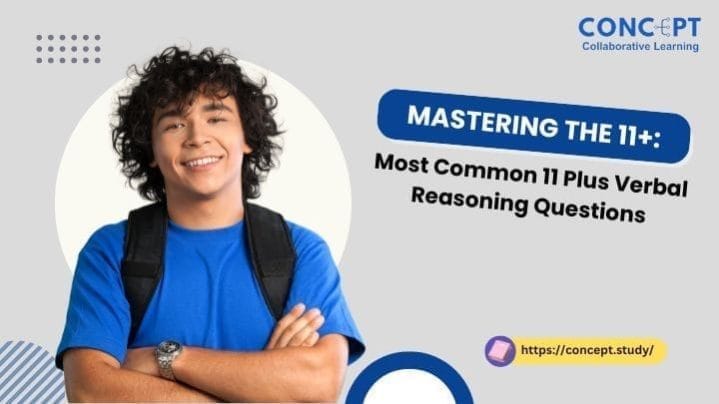Most Common 11 Plus Verbal Reasoning Questions
The 11 Plus Verbal Reasoning (VR) test is a critical part of the selective school entrance process in the UK. Designed to assess a child’s ability to reason with words and problem-solve, it includes various question types that examine their understanding of vocabulary, grammar, logic, and comprehension. To help parents and students prepare, we have compiled an in-depth guide to the most common types of 11 Plus Verbal Reasoning questions and how to tackle them effectively.
What is Verbal Reasoning?
Verbal reasoning tests evaluate a child’s ability to process information and solve problems expressed in words. These tests often go beyond the standard curriculum, requiring students to think critically and apply logic. By practising these question types, students develop strong language and analytical skills essential for success.
Common 11 Plus Verbal Reasoning Question Types
1. Synonyms and Antonyms
Students are required to identify words with similar or opposite meanings. For example:
-
- Synonym Example: Which word means the same as “benevolent”?
a) Kind
b) Harsh
c) Cruel
Answer: a) Kind
- Synonym Example: Which word means the same as “benevolent”?
-
- Antonym Example: What is the opposite of “elated”?
a) Joyful
b) Sad
c) Excited
Answer: b) Sad
- Antonym Example: What is the opposite of “elated”?
Tips for Success:
-
- Build a strong vocabulary by reading widely.
-
- Use flashcards or vocabulary apps for regular practice.
2. Word Analogies
Word analogy questions test the ability to recognise relationships between words. A typical format is: A is to B as C is to…?
Example:
Tree is to Leaf as Book is to…?
a) Page
b) Chapter
c) Word
Answer: a) Page
Tips for Success:
-
- Familiarise yourself with common relationships such as part-to-whole, cause-effect, or synonyms.
-
- Practise identifying the logic behind word pairs.
3. Code Words
Students must decode or encode words based on a pattern or rule. This question type requires a combination of logical thinking and pattern recognition.
Example:
If CAT is coded as DBU, how is DOG coded?
Answer: EPH (Each letter is replaced by the next one in the alphabet.)
Tips for Success:
-
- Break the problem into small steps to understand the pattern.
-
- Pay attention to alphabetical or positional shifts.
4. Letter Series and Sequences
These questions involve completing a sequence of letters based on a discernible pattern.
Example:
What comes next in the series: AB, BC, CD, DE…?
Answer: EF
Tips for Success:
-
- Look for consistent changes in the sequence, such as alphabetical progression.
-
- Write down the pattern to visualise the logic more easily.
5. Word Completion
These questions require identifying missing letters to complete a word.
Example:
C_ _PLETE (Hint: It forms a meaningful word.)
Answer: Complete
Tips for Success:
-
- Focus on context clues provided in the question.
-
- Practise spelling common words to improve speed and accuracy.

6. Letter and Number Codes
Students solve puzzles that involve converting letters to numbers or vice versa.
Example:
If A=1, B=2, C=3, what does the word CAB equal?
Answer: 3+1+2 = 6
Tips for Success:
-
- Practise linking letters to numbers.
-
- Use logical reasoning to spot relationships quickly.
7. Jumbled Sentences
Students must rearrange words to form a coherent sentence.
Example:
Arrange: sunny / today / is / the / day.
Answer: Today is the sunny day.
Tips for Success:
-
- Look for grammatical clues like capitalised words or punctuation.
-
- Identify the subject and verb first to frame the sentence correctly.
8. Odd One Out
Students are presented with a group of words and must select the one that does not belong.
Example:
Apple, Orange, Carrot, Banana
Answer: Carrot (it is a vegetable, not a fruit).
Tips for Success:
-
- Focus on categories like meaning, spelling, or grammatical roles.
-
- Eliminate options systematically.
9. Comprehension
Students answer questions based on a short passage. These test reading skills and the ability to infer information.
Example:
Passage: “Alice loves reading books about history and science.”
Question: What subjects does Alice enjoy?
Answer: History and Science
Tips for Success:
-
- Read the passage carefully and underline key points.
-
- Practise skimming for specific information.
10. Logical Reasoning
Logical reasoning questions assess a student’s ability to think critically.
Example:
All roses are flowers. All flowers need water. Do roses need water?
Answer: Yes
Tips for Success:
-
- Draw simple diagrams to visualise relationships.
-
- Read the question multiple times to understand its logic.
11. Hidden Words
These questions require finding smaller words within a larger one.
Example:
Find a word within: “Rectangle”
Answer: Angel
Tips for Success:
-
- Break the word into smaller parts.
-
- Focus on common prefixes or suffixes.
How to Prepare for 11 Plus Verbal Reasoning
1. Regular Practice
Consistent practice with sample papers and mock tests builds familiarity and confidence. Set aside daily time for verbal reasoning test.
2. Expand Vocabulary
Encourage students to read books, newspapers, and magazines to expose themselves to new words and contexts. Maintain a vocabulary journal for quick reference.
3. Master Time Management
Learn to balance speed with accuracy. Timed practice tests help students improve their pace and efficiency under exam conditions.
4. Use Online Resources
Numerous platforms provide interactive verbal reasoning exercises. Choose tools aligned with the 11 Plus exam format for targeted learning.
5. Seek Professional Guidance
Consider enrolling your child in a tuition programme or hiring a tutor specialising in verbal reasoning. Expert guidance can significantly enhance preparation.
Conclusion
Success in the 11 Plus Verbal Reasoning test is achievable with structured preparation and consistent practice. By understanding the most common question types and adopting effective study strategies, students can build the skills needed to excel. Remember, preparation is a journey—start early and stay committed. Exam Revision Guide for Online Learners

